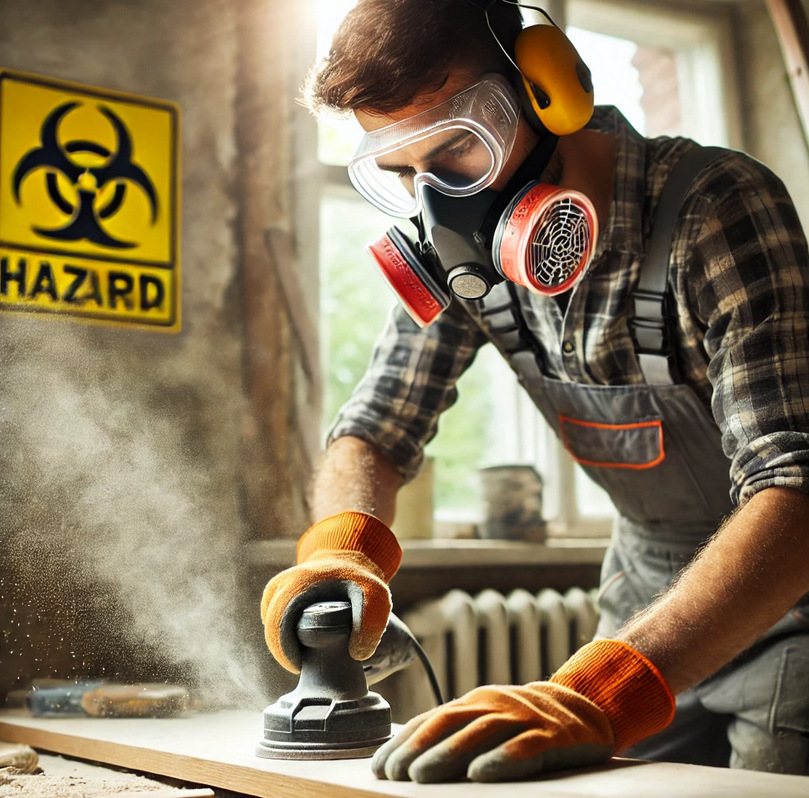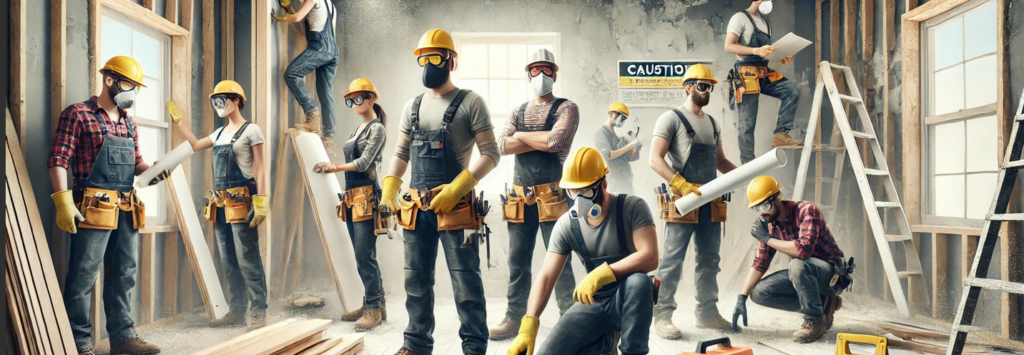Home renovation work can be rewarding but also exposes workers to a variety of occupational health hazards. From dust and chemical exposure to ergonomic strains and noise-induced hearing loss, renovation workers must take proactive steps to safeguard their health.

This article outlines key occupational health risks associated with house renovations and provides essential safety measures to mitigate these risks.
Common Occupational Health Hazards in Home renovation work
1. Exposure to Hazardous Materials
Many older homes contain hazardous materials that can pose severe health risks if disturbed. Common hazardous substances include:
- Asbestos – Found in insulation, flooring, and ceiling tiles, asbestos exposure can cause lung diseases such as asbestosis and mesothelioma.
- Lead Paint – Pre-1978 homes may have lead-based paint, which can cause neurological damage when inhaled or ingested.
- Mold & Fungi – Moisture-damaged areas may harbor mold spores that cause respiratory issues and allergic reactions.
Safety Measures:
- Conduct a hazardous material assessment before starting work.
- Wear respiratory protection such as N95 masks or P100 respirators when dealing with dust or hazardous particles.
- Follow containment procedures, including wetting materials and using HEPA vacuums to minimize airborne contaminants.
2. Respiratory Hazards from Dust & Chemicals
Demolition, sanding, and cutting materials release fine dust and volatile organic compounds (VOCs) that can damage the lungs over time.

Inhaling these particles may lead to chronic bronchitis, silicosis, or long-term respiratory complications.
Safety Measures:
- Always work in well-ventilated areas and use exhaust fans when handling chemicals.
- Use water suppression techniques to reduce airborne dust when cutting or grinding.
- Select low-VOC paints and adhesives to limit chemical exposure.
3. Noise-Induced Hearing Loss (NIHL)
Power tools such as drills, saws, and hammers produce noise levels above 85 dB, which can lead to permanent hearing damage if workers are exposed for long durations.
Safety Measures:
- Wear hearing protection such as earplugs or earmuffs when operating loud tools.
- Rotate tasks to limit prolonged exposure to high-noise environments.
- Use quieter, well-maintained power tools when possible.
4. Musculoskeletal Disorders (MSDs) from Heavy Lifting & Repetitive Tasks
Frequent lifting, bending, kneeling, and reaching can cause strains, sprains, and long-term musculoskeletal disorders such as back pain or carpal tunnel syndrome.
Safety Measures:
- Use proper lifting techniques – lift with the legs, not the back.
- Utilize mechanical aids like dollies and lifting straps to reduce strain.
- Take regular breaks to avoid overexertion.
Ergonomics & Work Posture: Preventing Long-Term Injuries
Many renovation tasks require workers to maintain awkward postures, which can lead to chronic pain or joint issues over time.
Safety Measures:
- Adjust workstations or use kneeling pads and back support to maintain a neutral spine position.
- Change positions frequently to avoid muscle fatigue.
- Stretch before and after work to improve flexibility and prevent stiffness.
Electrical and Fire Safety for Renovation Workers
Exposed wiring, faulty electrical installations, and flammable materials increase the risk of electric shocks and fires on renovation sites.
Safety Measures:
- Always turn off power before working on electrical components.
- Use ground fault circuit interrupters (GFCIs) to prevent electrical shocks.
- Keep fire extinguishers nearby when working with flammable materials like paints and solvents.
Heat Stress & Hydration for Outdoor Work
For renovations done in hot weather or poorly ventilated areas, workers are at risk of heat exhaustion and dehydration.
Safety Measures:
- Drink water regularly and avoid excessive caffeine or alcohol.
- Wear lightweight, breathable clothing and take shade breaks when working outdoors.
- Recognize early signs of heat stress, such as dizziness or excessive sweating, and take action immediately.
Mental Health Awareness in the Construction Industry
Renovation work can be physically and mentally demanding, with long hours, financial pressures, and safety concerns contributing to stress and burnout.
Safety Measures:
- Promote open communication about mental health and workplace challenges.
- Encourage regular breaks and reasonable work hours to prevent fatigue.
- Provide access to mental health resources such as counseling or peer support.
Conclusion
Home renovation workers face multiple occupational health risks, but with the right precautions, these dangers can be minimized. Proper training, use of personal protective equipment (PPE), adherence to safety guidelines, and prioritizing worker well-being are essential to ensuring a safe and healthy work environment.
By staying informed and proactive, renovation workers can protect themselves and their teams from long-term health complications.
For more safety resources, visit OHSE.ca. Stay safe and build smart!


No comments yet